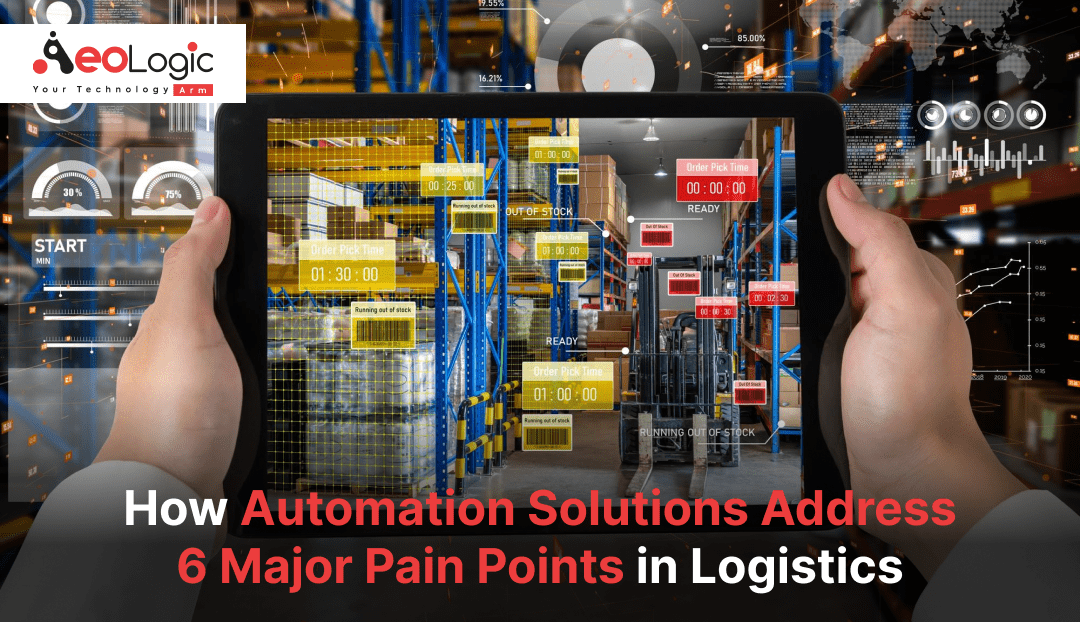In the logistics industry, efficiency is paramount. Companies face numerous hurdles as they navigate the complex interplay of transportation, warehousing, inventory management, and order fulfillment. Maintaining high service levels while managing costs is a significant challenge. Automation solutions in logistics have emerged as a powerful tool to tackle these issues effectively. This composition explores how automation solutions addresses six major pain points in logistics, offering insights into its transformative impact.
Also read: Automation in Logistics and Supply Chain Management
Understanding Automation Solutions in Logistics
Automation solutions in logistics involves the use of technology to execute tasks with minimal human intervention. This can range from robotic process automation (RPA) in back-office functions to autonomous vehicles in transportation. By integrating automation, businesses can streamline their operations, cut down on errors, and enhance overall efficiency.
Addressing Major Pain Points with Automation Solutions in Logistics
Inefficient Inventory Management
Effective inventory management is a critical challenge in logistics. Traditional inventory methods often rely on manual processes, which can lead to inaccuracies, stockouts, and overstocking. Automation revolutionizes inventory management by providing real-time tracking, automated replenishment, and predictive analytics.
– Real-Time Tracking: Internet of Things (IoT) solutions which includes sensors enable real-time visibility into inventory levels, locations, and conditions. This capability helps businesses forecast demand more accurately, reducing the risk of stockouts.
– Automated Replenishment: Automated systems can trigger restocking orders when inventory levels fall below predefined thresholds, ensuring that stock levels are optimized and reducing the likelihood of both overstocking and stockouts.
– Predictive Analytics: Automated analytics tools analyze historical data and market trends to forecast future demand with greater precision, enabling businesses to make informed decisions about inventory levels and reduce waste.
Complex Order Fulfillment
Order fulfillment involves multiple steps, from picking and packing to shipping and delivery. Manual processes can be slow and prone to errors, impacting customer satisfaction. Automation enhances order fulfillment by streamlining these processes:
– Automated Picking Systems: Technologies such as robotic pickers and automated guided vehicles (AGVs) expedite the picking process, reducing errors and increasing efficiency.
– Warehouse Management Systems (WMS): An automated WMS optimizes inventory placement within the warehouse, which minimizes travel time and boosts picking efficiency.
– Integrated Shipping Solutions: Automation integrates order processing with shipping carriers, automating the generation of shipping labels and documentation. It also provides real-time tracking updates to customers, improving transparency and customer experience.
High Transportation Costs
Transportation costs are a significant expenditure in logistics, and inefficiencies can lead to inflated expenses. Automation helps optimize transportation and reduce costs through:
– Route Optimization: Automated route planning tools use algorithms to identify the most efficient routes by considering factors such as traffic, weather conditions, and delivery windows. This optimization reduces fuel consumption and transit times.
– Load Optimization: Automation maximizes the utilization of space in transportation vehicles, decreasing the number of trips required and lowering associated costs.
– Freight Audit and Payment Automation: Automated systems audit freight bills for accuracy
and process payments efficiently, helping to prevent overcharges and reduce administrative overhead.
Limited Visibility and Transparency
A lack of visibility into the supply chain can lead to inefficiencies, delays, and increased costs. Automation enhances supply chain visibility and transparency, which supports better decision-making and proactive problem-solving:
– Real-Time Tracking and Monitoring: IoT devices and GPS tracking offer real-time updates on shipment status and location. This visibility allows businesses to monitor progress closely and address any issues promptly.
– Blockchain Technology: Blockchain creates a transparent, tamper-proof record of transactions, improving trust and accountability among supply chain partners by ensuring data integrity.
– Data Analytics and Reporting: Automated systems collect and analyze data to provide insights into supply chain performance. This analysis helps businesses identify bottlenecks, optimize processes, and make data-driven decisions.
Labor Shortages and Workforce Challenges
The logistics industry is experiencing a growing shortage of labor, particularly in roles such as truck drivers and warehouse workers. Automation can help mitigate these challenges by performing tasks that are labor-intensive or repetitive:
– Robotic Process Automation (RPA): RPA handles routine back-office tasks like data entry, order processing, and invoicing, allowing human workers to focus on more strategic and complex activities.
– Autonomous Vehicles: Self-driving trucks and delivery drones address driver shortages by reducing the reliance on human drivers, thus improving delivery efficiency and reliability.
– Automated Warehousing: Technologies like automated storage and retrieval systems (AS/RS) and robotic pickers perform tasks traditionally done by warehouse workers, boosting productivity and lowering labor costs.
Customer Service and Satisfaction
In the competitive logistics market, superior customer service is crucial. Automation enhances customer service by improving order accuracy, reducing delivery times, and providing real-time updates:
– Chatbots and Virtual Assistants: Automated customer service tools handle inquiries, track orders, and offer 24/7 support, enhancing the customer experience and ensuring timely responses.
– Real-Time Notifications: Automation enables real-time notifications regarding order status, delays, and delivery times. This keeps customers informed and reduces uncertainty.
– Data-Driven Personalization: Automated systems analyze customer data to offer personalized recommendations and promotions, improving customer satisfaction and fostering loyalty.
Benefits of Automation in Logistics
Automation brings several key benefits to the logistics industry:
– Increased Efficiency: Automation solutions in logistics reduces the time and effort needed for various tasks, leading to greater overall productivity and streamlined operations.
– Cost Savings: By optimizing processes and minimizing errors, automation results in significant cost savings in areas such as labor, transportation, and inventory management.
– Improved Accuracy: Automated systems reduce errors compared to manual methods, ensuring accurate inventory counts, order fulfillment, and billing.
– Enhanced Visibility: Real-time tracking and monitoring offer better insight into the supply chain, enabling more informed decision-making and proactive problem resolution.
– Scalability: Automation facilitates easier scaling of operations, allowing businesses to handle increased volumes without a proportional rise in labor costs.
Challenges in Implementing Automation
Despite its clear benefits, implementing automation presents several challenges:
– High Initial Costs: The upfront investment in automation technology can be substantial. However, the long-term cost savings and efficiency improvements often justify this initial expense.
– Integration with Existing Systems: Integrating new automation solutions with existing systems and processes can be complex. It is crucial to select compatible technologies and work with experienced vendors to ensure a smooth transition.
– Employee Training and Adaptation: Workers may require training to operate new systems, and there may be resistance to change. Effective communication and support are essential to facilitate a smooth transition and address any concerns.
Also read: Automation Solutions for Warehouse Operations in E-commerce
Conclusion
Automation is revolutionizing the logistics industry by addressing key challenges and offering significant benefits in terms of efficiency, cost savings, and customer satisfaction. By leveraging advanced technologies such as IoT, AI, and blockchain, businesses can overcome issues related to inventory management, order fulfillment, transportation costs, visibility, labor shortages, and customer service. Embracing automation enables companies to streamline operations, improve accuracy, and stay competitive in an evolving market.







